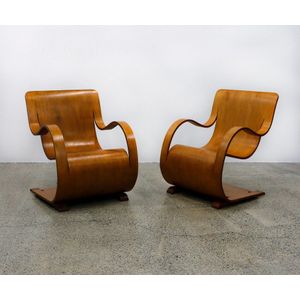The Iconic Curvesse Chair: A Lost Design Legacy
Garth Chester, an original pair of Curvesse chairs, designed in 1944, the Curvesse chair is an icon of New Zealand design. Author Douglas Loyd-Jenkins, in his book at home: a century of New Zealand design, notes that the Curvesse chair was the first cantilevered plywood chair to appear anywhere in the world a progressive high point in local design. Inspired by the Bauhaus and international designers such as Marcel Breuer and Alvar Aalto, the Curvesse chair marries international form to a unique kiwi Diy, no. 8 wire philosophy. The chair is made from several thin sheets of water-glue softened plywood, with two lengthwise cuts forming the arms, laminated together in a mould and pressed until set, and with solid runners providing a stable base. The failure rate was said to be one in five. There are no definitive numbers on how many were manufactured, but the chair was ultimately a commercial failure, and most estimates suggest less than 500 were produced. Unfortunately, a mysterious fire burnt down Chesters workshop and destroyed all the presses and production equipment in the process. This led to a change in direction for the designer who then moved on to designing steel-framed furniture.
You must be a subscriber, and be logged in to view price and dealer details.
Subscribe Now to view actual auction price for this item
When you subscribe, you have the option of setting the currency in which to display prices to $Au, $US, $NZ or Stg.
This item has been sold, and the description, image and price are for reference purposes only.
- Bauhaus - Bauhaus refers to design concepts that originated at the German art school of the same name that was founded in 1919 by architect Walter Gropius. The school was based on the principles of modernist design, and sought to bridge the gap between art and industry by teaching students how to create functional and aesthetically pleasing designs for mass production.
Bauhaus had a significant impact on modern design and architecture, and is widely considered to be one of the most influential art schools of the 20th century. The school's approach to design emphasized simplicity, functionality, and the use of new materials and technologies. Bauhaus designers sought to create clean, uncluttered designs that were free from unnecessary ornamentation.
Bauhaus had a strong influence on a wide range of artistic fields, including architecture, furniture design, typography, and graphic design. Some of the most iconic examples of Bauhaus design include the Barcelona Chair by Mies van der Rohe, the Bauhaus Building in Dessau by Walter Gropius, and the typography of Herbert Bayer.
Bauhaus was active from 1919 until 1933, when it was forced to close by the Nazi government. However, the school's ideas and principles continue to be influential in design and art to this day. - Runners - Runners or slides are wood on each side of the bottom of a drawer, being the surfaces which take the weight of the drawer and provide for its movement in and out. The runners of a drawer are usually the first areas of a drawer to display wear, due to the friction between the two surfaces. In modern cabinet making the wooden runners on th ebottom of the draer have been replaced by metal runners fixed to the side of the drawer and the side of the cabinet.
This item has been included into following indexes:
